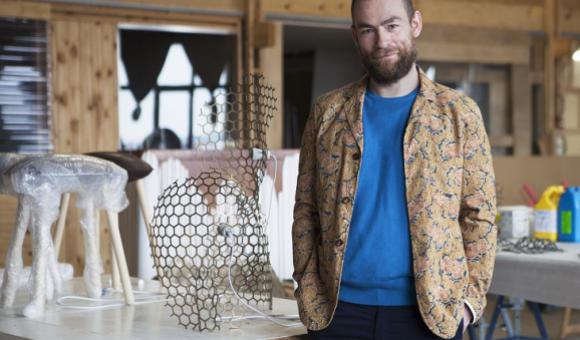
This year, at Milan Design Week, Damien Gernay associated his talent with the leatherworking firm Delvaux as part of the exhibition “Tradition and Technology: a matter of perception”.
You have to climb several solid flights of stairs to get to Damien Gernay’s studio in Molenbeek, a time spent isolating yourself from the world and getting ready to enter the universe of this artist-designer. It is a sensual, sensitive universe that has seen elegant pieces brought to life, such as the honeycombed lamp Veiled Lady, the Textured cabinet with its melting wood, or even the delicate Bloated stool, inspired by the bellies of mothers-to-be.
This year, at Milan Design Week, Damien Gernay associated his talent with the leatherworking firm Delvaux as part of the exhibition “Tradition and Technology: a matter of perception”. It highlighted 13 designers and 13 businesses from different sectors in Belgium, partnered to create new products or prototypes. A satisfying and enriching experience.
You’ve only just got back from Milan Design Week. What’s your immediate feeling about this year’s event?
Milan is an important meeting place. I devote three to four months a year to the event. This year, I presented three pieces there: the one from the cooperation with Delvaux and two pieces produced for the Italian brands Mogg and Durame. This year, there was a lot of direct feedback, so I can say that for me it’s been a “good Milan”! The exhibition, organised by Belgium is Design, creates a great deal of anticipation. That makes it possible to create connections and be in contact with pieces you wouldn’t have had a chance to discover during the rest of the year.
How did your cooperation with Delvaux go?
I’ve been working with leather for a long time and I was enthusiastic about working with Delvaux from the word go. I then needed to convince them that doing slightly more experimental things could also be interesting for them. We agreed to do some work based on coverings and colour. After our first meeting, I walked home – about ten kilometres – so I could think. At that point, I wanted to suggest a trace of a brushstroke, just a dash of colour. A work evoking beads or layers. I wanted a very instinctive, quick, effective gesture, counterbalanced by ultra-detailed, time-consuming work. An approach moving in two times. The artistic way is to turn an image into an object. I developed a tool and made the plaster myself. I really like diverting the material, so at first sight there is no evidence of it. From a distance, you would say it was plaster and then when you come closer, you see the exceptional leatherwork.
Leatherwork made by the craftsmen of the House of Delvaux?
It was a terrific challenge. I never develop the concept beginning with the function; that always comes from a poetic idea or an image. I was lucky enough to work with a very talented colleague. We did several trials and had a lot of discussions before improving things. The idea was to present a false truth; for it to look as if it was plaster, but really to be leather. We spent a long time looking for the white that was closest to plaster. Technically, I learned a tremendous amount from this project, which will definitely be useful for me in the future. Delvaux has developed an interesting, generous and accessible way of working. Their leather collection is simply magnificent.
And what about your way of working?
Computer work is important, but I need to work with the material, to grope around, to make mistakes. And each mistake can be the starting point for a new project. I feel wrong about suggesting a material if I haven’t touched it. And my work is only really based on diverting materials. You have to take the material to the right place. And invent different languages via associations with other materials. For me, creating a piece is a leap into the void. I’m always in the studio. In Belgium, our luxury is having enough space for creating. In Brussels, I love the feeling of being in a capital city and a village at the same time. As soon as you step into this city, you feel at home.
Estelle Toscanucci